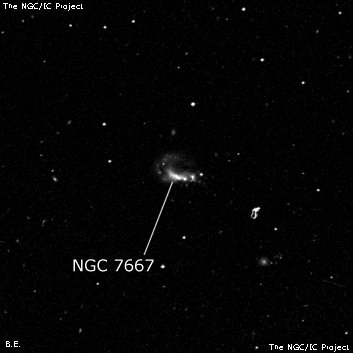
Brother Gaspare Ferrari discovered NGC 7667 = Nova #9, along with NGC 7668, 7669 and 7670, on 21 Dec 1866 (AN 1571) while searching for Biela's Comet at College Romain with a 9.5-inch refractor. He simply noted "vF" and "three [others] surround the 9th [NGC 7667] in the field." There is nothing near his position (determined using the setting circles). RNGC and PGC identify UGC 12578 as NGC 7667. This galaxy is 3.0 min of RA west and 4.5' north of Ferrari's position, so is a very uncertain identification and the number could be considered lost. Neither UGC, MCG, CGCG nor ESGC identify UGC 12578 as NGC 7667. See Harold Corwin's identification notes.
400/500mm - 17.5" (8/31/86): very faint, very diffuse, elongated 3:2 E-W. A faint star is 2' N and another 6' ENE (mag 14.5/15 double at 16"). UGC 12589 lies 12' NE.
600/800mm - 24" (9/29/16): at 375x; very faint, fairly small, elongated 3:2 ~E-W, ~30"x20", low even surface brightness (surprisingly faint). This is highly irregular or disrupted merger with several blue knots on the western half, but these were not noticed. UGC 12589 lies 12' NE. This peculiar galaxy (another merger?) appeared extremely faint, fairly small, very elongated 5:2 or 3:1 SW-NE, 30"x12", very low surface brightness.
900/1200mm - 48" (10/27/16): at 488x; fairly faint, large, elongated roughly 5:2 E-W but the shape is irregular. Low though uneven surface brightness with no core. The galaxy bends to the north on the east side and spreads out into a very low surface brightness haze.
This barred Magellanic irregular (possible merger) contains a series of blue HII knots along the west side and three were seen at 488x. A very faint stellar or quasi-stellar knot (UM 160 NED1) is detached off the west end. A slightly brighter tiny knot (UM 160 NED2) is close ESE [by 15"], at the west edge of the galaxy. A third collinear knot (UM 160 NED3), 15" further ESE, was intermittently visible. The NED designations are from the University of Michigan emission line survey.
UGC 12589, located 12' NE, appeared fairly faint, moderately large, very elongated 3:1 ~SW-NE, ~1.0'x0.3', small brighter central region. This peculiar galaxy has an unusual shape, hooking counterclockwise on the southwest side and extending a short distance [~0.3'] due west. The galaxy tapers on the northeast end. It forms a pair with LEDA 214957 1.2' NE.
Notes by Steve Gottlieb